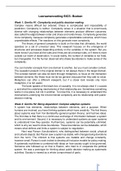Leersamenvatting BICS: Boeken
Week 1: Gerrits H1: Complexity and public decision making
Complex means difficult but ordered; Chaos is complicated and impossibility of
prediction; Complexity is neither. Complexity arises in a situation that is enormously
diverse with changing relationships between elements produce different outcomes;
also called the edge between order and chaos and randomness. Complexity generates
more complexity, because complexity generates unpredictable outcomes, which have
unpredictable effects. The reactions on this generate more complexity.
The theory of general complexity is build on the idea that ultimately, the world
operates on a set of universal rules. This viewpoint focuses on the emergence of
structures and processes depending entirely on the variables in the system. But you
never know if you have all the rules and if they are all universal rules, or if there is more
outside our realm of observation. In social reality, the number of variables is not fixed,
but changeable. It is the human observed who draws boundaries to make sense of the
complexity.
You can transfer concepts from one domain to another, but you must consider context.
The causation present in the original domain is not always there in the target domain.
The concept transfer can also be done through metaphors, to focus on the interaction
between domains. But these must not be too general, because then they add no value.
Metaphors can offer a different viewpoint, but if a closer look reveals only more
metaphors, it is not useful.
The book speaks of the black box of causality. It is not always clear if x causes
y, and what the underlying mechanisms of that relationship are. Sometimes something
works in one place, but not in another. To know this, it is necessary to understand the
mechanisms underlying the environmental complexity and its relationship with public-
decision making.
Week 3: Gerrits H2: Being dependent: Complex adaptive systems
A system has elements, relationships between elements, and a purpose. When
humans are involved, you have thinking systems which have creativity. The first theory
about systems was from Von Bertalanffy (general system theory), and had two ideas.
The first idea is that there is a continuous exchange of information between a system
and its environment. Second, it is necessary to understand systems as open systems
to understand how they operate. Furthermore, systems can be potentially unlimited,
which is why we need to draw boundaries. These boundaries can be debatable, which
means what defines and limits a system is subject to negotiation.
Next was Parson (functionalism), who distinguished between social, physical
and cultural objects. But Parson saw a system as stable, with changes being deviations
from the norm. The criticism is that systems are instable and change constantly,
however small. Parson’s work incited to develop all-inclusive models for policy making.
A systematic worldview is combined with ideas on how society ought to be governed.
Someone who followed up on that is Easton, who tried to in cooperate the political
system. He was a prototype for thinking about public decision-making as systematic
activities. Society is viewed as a whole compromised of parts.
1
, Humans are adaptive and learning, and are part of systems. Checkland (focus on
communication and meaning) argues that a researcher studying a social system is
himself part of the system. Semiotics (studying signs and meanings) is what makes
the system. According to him, researcher should learn the system than working in it
rather than observing it from the outside. Pure observation does not exist. For him,
action in systems are driven by meaning, and systems become real through humans
giving meaning to it. He called his approach soft systems methodology.
Churchman focuses on how systems emerge through individual judgements,
especially concerning boundaries. This helps people understand systems, but also
underlines that a full understanding of the system is impossible. Systems are
unmanageable, cannot be fully organized, and it is impossible for people to fully know
systems. Systems are learning and develop through interaction between elements.
This group of less mechanistic systems definitions are called complex adaptive
systems (CAS).
Power is distributed over different actors in a system. This means policy making also
has different actors, not just the government. There are different policy arenas and
policy networks. These have multilateral relationships and are heterogenous. A policy
making network is not stable, but have changing boundaries and relations between the
actors in the network.
Luhmann developed a general theory of social systems with attention to policy.
He builds on the idea that people form mental modes from which they reason to help
them deal with reality. The organization of government is shaped through
communicative connections between people, both bureaucratic and informal.
Repeated communicative acts make a system. The identity of the system is formed
and maintained through communications. Boundaries are negotiable. Every individual
forms their own idea of the system around a certain policy.
Hierarchies exist in complex system to help structure it. It makes it more
efficient, also in communication, and it helps build up redundancy which makes it more
resilient. In complex systems, hierarchies intersect with each other and horizontal
relationships. They can both help and hinder through restrictions.
Three properties common to most CAS definitions are described.
- Systems emerge through spontaneous, unplanned interactions between
heterogenous actors. Repeated interaction makes a system (emergent).
- Actors in a system are adaptive. Structure, processes and norms are flexible
and are collective individual response to changes or incentives from the outside.
Everyone build their own mental model of a system. If a system emerges out of
interaction, it is dynamic and adaptive.
- There is a non-linear relationship between actions of individual actors and the
behaviour of the entire system.
Systems and system definitions are recursive: the parts mirror the whole but each part
has it own focus and can differ greatly from the others.
2






